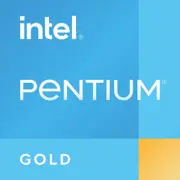Intel Pentium Gold G6500T

Intel Pentium Gold G6500T: Processore budget per compiti di base nel 2025
Aggiornato: aprile 2025
Introduzione
Nell'era dei processori multicore e delle reti neurali, anche i chip budget continuano a essere richiesti. L'Intel Pentium Gold G6500T, lanciato nel 2020, è ancora disponibile sul mercato grazie al suo basso costo (circa $50–60) e alla sua efficienza energetica. Vediamo a chi si adatta questa CPU nel 2025 e quali compromessi potrebbero essere necessari.
1. Caratteristiche principali
Architettura e processo tecnologico
Il processore è basato sull'architettura Comet Lake (10ª generazione di Intel Core) con un processo tecnologico di 14 nm. Si tratta di una tecnologia datata, ma sufficiente per compiti semplici.
- Core e thread: 2 core, 4 thread (Hyper-Threading).
- Frequenza base: 3.5 GHz, nessun turbo boost.
- Cache: 4 MB L3.
- TDP: 35 W — ideale per sistemi compatti.
Caratteristiche chiave:
- Intel UHD Graphics 630 — grafica integrata con supporto 4K@60 Hz (HDMI/DisplayPort).
- Supporto per Intel Quick Sync Video — accelerazione della codifica video.
- Efficienza energetica — adatta per il raffreddamento passivo.
2. Schede madri compatibili
Socket e chipset
- Socket: LGA 1200.
- Chipset: H410, B460, H470, Z490 (per Comet Lake).
Raccomandazioni per la scelta:
- Opzione budget: H410 (prezzo $50–70) — adatta per PC da ufficio.
- Miglior scelta: B460 ($70–90) — supporto per USB 3.2 Gen 2, più porte SATA.
- Importante: Evita i chipset della serie 500 (ad esempio B560), poiché non sono compatibili con Comet Lake.
Esempio pratico: La scheda ASRock B460M-HDV a $80 offre un funzionamento stabile con DDR4-2666 e dispone di 4 slot di memoria.
3. Tipi di memoria supportati
- Tipo: DDR4 (DDR5 e LPDDR4 non sono supportati).
- Frequenza massima: 2666 MHz (limitazione dei chipset H410/B460).
- Modalità: Doppio canale (si consiglia di installare due moduli).
Volume consigliato:
- Compiti di base: 8 GB (2x4 GB).
- Multimedia: 16 GB (2x8 GB) — per lavorare con il browser e lo streaming video.
Consiglio: Scegli una memoria con latenze basse (CL16) per un leggero incremento delle prestazioni.
4. Raccomandazioni per l'alimentatore
- Potenza: Anche considerando una scheda grafica dedicata (ad esempio, GTX 1650), è sufficiente un alimentatore da 400 W.
- Per sistemi senza scheda grafica: Sono sufficienti 250-300 W.
Esempi:
- Opzione budget: EVGA 400 W1 ($35) — certificazione 80+ White.
- Scelta affidabile: Corsair CX450 ($55) — 80+ Bronze, design semi-modulare.
Importante: Non risparmiare sull'alimentatore: i modelli economici possono danneggiare i componenti.
5. Pro e contro
Pro:
- Prezzo: Uno dei processori più accessibili nel 2025.
- Efficienza energetica: Adatto per mini-PC e sistemi con raffreddamento passivo.
- Grafica integrata: L'UHD 630 gestisce video 4K e giochi semplici (ad esempio, Minecraft a impostazioni basse).
Contro:
- 2 core: La multitasking è limitata — l'apertura del browser con 20 schede e compiti in background può causare rallentamenti.
- Architettura datata: Risulta inferiore rispetto agli APU AMD moderni in termini di prestazioni per watt.
- Assenza di supporto PCIe 4.0 — rilevante solo per unità NVMe ad alta velocità.
6. Scenari d'uso
Compiti d'ufficio
- Lavoro con documenti, videoconferenze, email.
- Esempio: Un sistema basato su G6500T, 8 GB di DDR4 e SSD da 256 GB — ideale per il lavoro remoto.
Multimedia
- Visione di video 4K, streaming (Netflix, YouTube).
- Limitazione: Assenza di supporto hardware per AV1 — i servizi di streaming nel 2025 potrebbero richiedere un aggiornamento hardware.
Giochi leggeri
- Intel UHD 630: CS:GO a 720p (30–40 FPS), Dota 2 a impostazioni basse.
- Consiglio: Aggiungere una scheda grafica di livello GTX 1650 ($120) per il gaming in FullHD.
Server domestico
- Il basso consumo energetico consente di utilizzare la CPU in un NAS o un media center (ad esempio, con software Plex).
7. Confronto con i concorrenti
AMD Athlon 3000G (prezzo $45)
- Pro: Grafica Vega 3 più potente, moltiplicatore sbloccato.
- Contro: Assenza di Hyper-Threading, socket AM4 obsoleto.
Intel Celeron G6900 (prezzo $55)
- Pro: Architettura Alder Lake (10 nm), 2 core/2 thread.
- Contro: Inferiore nelle attività multithreading.
Conclusione: G6500T vince grazie all'Hyper-Threading, ma perde nella grafica contro l'Athlon.
8. Consigli pratici per l'assemblaggio
- Case: Scegli modelli compatti (ad esempio, Fractal Design Core 500) per risparmiare spazio.
- Raffreddamento: Il cooler di serie è sufficiente, ma per un funzionamento silenzioso si può optare per il Noctua NH-L9i ($45).
- Archiviazione: Utilizzare sempre un SSD (ad esempio, Kingston A400 da 480 GB a $30).
- Opzioni di rete: Aggiungere un adattatore Wi-Fi (ad esempio, TP-Link Archer TX50E a $40), se la scheda madre non ha un modulo wireless.
9. Conclusioni: A chi si adatta il Pentium Gold G6500T?
Questo processore è la scelta per chi:
1. Sta assemblando un PC budget per ufficio, studio o navigazione in Internet.
2. Ha bisogno di un sistema a basso consumo energetico (ad esempio, server domestico).
3. Intende utilizzare il PC come media center con supporto per video 4K.
Perché non scegliere G6500T nel 2025?
- Per giochi e montaggio video è meglio optare per APU AMD Ryzen 3 5300G ($90) o Intel Core i3-12100 ($110).
- Se serve una piattaforma moderna con supporto per DDR5 e PCIe 5.0, considera i processori Alder Lake o Ryzen 7000.
Conclusione
L'Intel Pentium Gold G6500T è un esempio di "mulo da lavoro" per compiti poco impegnativi. Con un prezzo di $50–60 rimane attuale nel 2025, ma andrebbe considerato solo in caso di budget limitato. Per futuri aggiornamenti è meglio scegliere una piattaforma più moderna.
Di base
Specifiche della CPU
Specifiche della memoria
Specifiche della GPU
Varie
Classifiche
Rispetto ad altre CPU
Condividi sui social media
Oppure linkaci
<a href="https://cputronic.com/it/cpu/intel-pentium-gold-g6500t" target="_blank">Intel Pentium Gold G6500T</a>